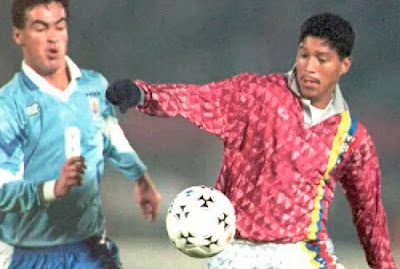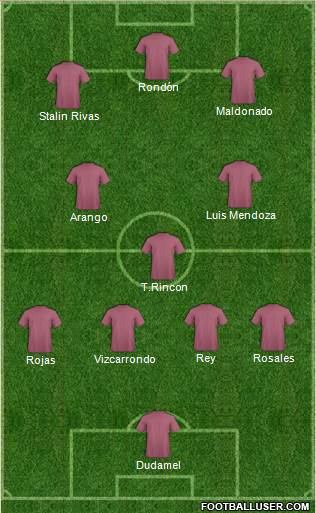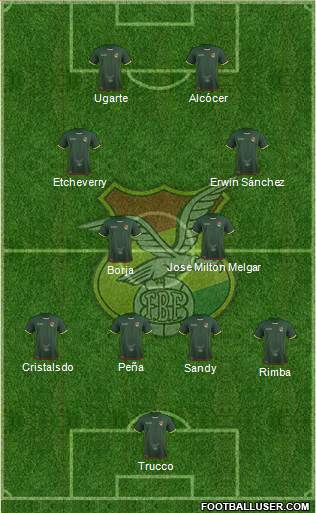-- The IFFHS created their All-Time Best XI for Venezuela. Their team included Rafael Dudamel, Roberto Rosales, José Manuel Rey, Oswaldo Vizcarrondo. Jorge Alberto Rojas, Luis Carlos Mendoza, Tomás Rincón. Stalin Rivas, Juan Arango. Salomón Rondón and Giancarlo Maldonado.
-- This was Marca's list of greatest ever footballers from Venezuala. They were Juan Arango, Stalin Rivas, Giancarlo Maldonado, Alejandro Moreno, Salomón Rondón, Giovanni Savarese, Tomás Rincón, José Manuel Rey, Renny Vega and Oswaldo Vizcarrondo. -- I found a youtube video created by Armando Naranjo. He is a sports announcer specializing in soccer for radio and TV for more than 20 years in Venezuela. His greatest ever Best XI included: Rafael Dudamel, Roberto Rosales, José Manuel Rey, Frederic Elie, Jorge Alberto Rojas, Luis Carlos Mendoza, Tomás Rincón, Stalin Rivas, Juan Arango, Salomón Rondón and Pedro Febles. He had two changes from IFHHS. Giancarlo Maldonado and Oswaldo Vizcarrondo were missing from his team. -- Venezuela reached the semifinal of Copa America in 2011. In Argentina, they held Brazil to goalless draw. In the semifinal, they narrowly lost to Paraguay through a penalty shootout. This team was loaded with players from that team. Renny Vega, Juan Arango, Oswaldo Vizcarrondo, Tomas Rincon, Gabriel Cichero, Giancarlo Maldonado, Roberto Rosales and Salomón Rondón came from that team. Their rise actually began 4 years earlier when they reached the quarterfinal of the 2007 Copa America held at home. They also had their best ever World Cup Qualifying result up until that point during the World Cup Qualifying rounds for the 2010 World Cup Finals. They managed to steal a point against Brazil. Four years later, they beat Argentina 1-0 in another World Cup Qualifier. That generation was their best ever.
-- Until 2011, their best finish at the Copa América was fifth in their first entry, in 1967. I took three players from that 1967 team. They were Luis Mendoza, Freddy Ellie and David Mota. Rafael Santana and Antonio Ravelo deserved to be on this team, but their position was covered by other players.
-- Jorge Valdivia was born in Venezuela, but both of his parents were Chilean. He also represented Chile in football, where he earned 74 caps between 2004 and 2017. He starred in Brazil's Serie A in which he was named in the 2007 Bola de Prata. Danny (Portrugal) was also born in Venezuela. He played over 30 times for Portugal. He was a star player with Zenit St Petersburg. He was named Russian Footballer of the Year in 2010. Both would have been selected to this team if they chose to play for Venezuela. Leonardo Jardim is a famous Portuguese coach who was known for leading AS Monaco to win the French league title in 2017 ahead of PSG. His team featured young players such as Kylian Mbappe, Bernardo Silva, etc. He was born in Venezuela, but I did not know much about his playing career.
Goalkeepers
-- According to different sources, Rafael Dudamel, Gilberto Angelucci and Renny Vega were the three greatest ever goalkeepers from Venezuela. The three were also the most capped goalkeepers from here.
-- Rafael Dudamel scored 24 goals in his career, but only one of them was for La Vinotinto. He scored a direct free kick in a 1998 World Cup qualifier against Argentina. He also won league titles in Venezuela, Colombia and South Africa. Marca listed Renny Vega as one of the top 10 greatest footballers from here. Angelucci is currently a fugitive from justice after disappearing during investigation for a homicide in his native Turén, but this did not affect his status with this team.
 |
| Renny Vega |
-- At the time of writing, Wuilker Faríñez's club career has not worked out in France, but he has the potential to earn a spot on this team. I left him off the team for now.
-- Dani Hernandez was the first Venezuelan goalkeeper to play in Spain, but he mainly played in the lower division. Some people rated him as one of the greatest ever from Venezuela, but I put him as my 4th goalkeeper.
-- I also looked into Daniel Nikolac, César Baena, and Daniel Francovig. Nikolac was ranked very high. He helped Venezuela to win the Gold medal at the Central American and Caribbean Games in 1982, but it was not a senior tournament, I believed. At the senior level, he only played 5 times, largely because he often refused callups.
-- For his club team Unión Atlético Táchira, Daniel Francovig scored a goal from a dropkick from his penalty box against Independiente of Argentina in the 1987 Copa Libertadores. His club went on to upset the Argentine club. It was a monumental moment in their football history.
-- I also discovered Vicente Vega who is the father of Renny Vega. He played with Jairzinho (Brazil's 1970 World Cup team) for Portuguesa Football Club in the late 1970's. For Venezuela, he achieved a moral victory in 1981 when he held Brazil to a 1-0 loss during a World Cup Qualifier. Brazil only broke the deadlock by a penalty taken from Zico. Please don't forget we were talking about the team that would become Brazil's legendary 1982 World Cup team.
Defenders
-- Oswaldo Vizcarrondo, Roberto Rosales and Jose Manuel Rey were the greatest defenders from Venezuela.
 |
| Jose Manuel Rey |
-- Roberto Rosales was chosen by IFHHS as their best ever rightback. He was an important player during his time in Spain's Malaga. I came across a rightback named René Torres from the 1980's, but I took David Mota as my backup. He played for Deportivo Galicia for more than 15 years. He played in the 1967 Copa America team.
-- On the left, I first took Jorge Rojas who was also IFFHS's choice. He was voted as the best foreign player while playing in Ecuador. He was a leftback/wingback. Jonay Hernandez played mainly in Spain's Segunda División B where he appeared in 212 matches over one full decade. He was a strong prospect for this team, but I took Gabriel Cichero instead. He was from the 2011 Copa America team. His brother Alejandro Cichero was as famous as Gabriel. He was a well-known central defender who spent some time in Benfica and Caligari, but the majority of his club career was spent with smaller clubs. He also played as a fullback, but I believed on the right. This team needed a leftback so I took his brother instead. Their father Mauro Cichero captained Venezuela Olympic team at the 1980 Olympics. He was also a defender.
-- Oswaldo Vizcarrondo was named on the Team of the Tournament at the 2010 Copa America. As mentioned, he was one of Venezuela's greatest defenders. Then, I took Freddy Elie whom I considered to be an historical player. Jose Manuel Rey was one of the most capped players ever from Venezuela. He is also their third all-time leading scorer even through he was a defender.
-- The last centreback was more controversial. Fernando Amorebieta switched to play for for Vinotinto late in his career. He only represented Venezuela 15 times in which some Venezulans might disagree with his selection, especially after I dropped Pedro Accosta and Luis Vallenilla. His club career, however, was very good for players from this country. He played in 253 competitive matches over eight La Liga seasons.
-- In 2018, I selected 6 central defenders, but in 2023, I decided to reduce the number. First, I dropped Pedro Acosta. He made 34 appearances for the senior Venezuela national football team from 1979 to 1989, including participation at the 1979 Copa América, 1983 Copa América, 1987 Copa América and 1989 Copa América. He also competed at the 1980 Summer Olympics in Moscow. He scored the goal against Bolivia in 1981 that gave Venezuela its first ever victory in a World Cup Qualifier. Acosta played for Deportivo Galicia, C.S. Marítimo de Venezuela and Caracas F.C. I also decided not to take Luis Vallenilla. He made 77 caps for Venezuela, scoring a goal. For club football, he played for Trujillanos, Caracas and Mineros de Guayana.
-- I came across several defenders who had built strong cases for this team. Leonel Vielma's name was mentioned frequently during my research. Pedro Castro was on trial with several Spanish clubs in the 1970's, which would have been a milestone for players from here. David Mcintosh and Hector Rivas were also mentioned.
-- Jose Manuel Velasquez was a centreback who spent some time playing in Europe. Please do not confuse him with José Velásquez who was the standout Peruvan defensive midfielder from the 1978 and 1982 World Cup Finals.
Midfielders/Wingers
-- Tomas Rincon was able to have a career in Serie A and Bundesliga, which was a big accomplishment for players from Venezuela. He was also at one point on the book of Juventus. Then, I selected Miguel Vitali who had over 80 caps. He was followed by central midfielder Gabriel Urdaneta who was the third most-capped player in Venezuela's history when he retired.
-- In 2018, I also selected CM/DM: Leopoldo Jiménez, but I dropped him in 2023. He played club football for a number of professional clubs in both Venezuela and abroad, including Once Caldas in Colombia, Córdoba CF in Spain, FC Alania Vladikavkaz in Russia, Aris Limassol in Cyprus, for Deportivo Chacao in Venezuela where he spent his best years. He also played 64 times for the Venezuela between 1999 and 2005. I also discovered Carlos Betancourt through Facebook discussions. He played in the 1980's, but he seemed to be a forgotten player. He was a defensive midfielder, I believed. I also put Franklin Lucena on honorable mention.
-- As of November, 2023, Yangel Herrera is only 25 years old. He was the captain of the Venezuela U20 team that finished second in the 2017 U-20 World Cup. He was signed by Manchester City, but he spent his entire stint there out on loan. It would have a few more seasons before I decided on his selection. He is now with Girona. At the time of writing, they surprised everyone by sitting on top of La Liga table ahead of both Real Madrid and Barcelona after 13 games played
-- Juan Arango was considered one of the greatest players ever from his country. He was a star player in La Liga with Mallocra and in the Bundesliga with Borussia Mönchengladbach. With 129 caps, he is Venezuala's All-Time cap leader. Luis Mendoza was considered the greatest Venezuelan footballer before the 1990's. He was the youngest ever player to play in the top division of Venezuela.
 |
| Luis Mendoza |
-- Uruguay-born Gabriel Miranda was well-respected, but he naturalised late in his career. He only played 12 times for La Vinotinto. Alejandro Guerra became the first Venezuelan footballer to win the Copa Libertadores in 2016. He was also selected as the Best Player of the tournament. However, people seemed to rank him below the players I have selected. Luis Manuel Seijas played around the same time. His name was mentioned a few times. But I did not have enough space for them.-- This team lacked a respectful right-side attacker. So I seriously looked into Jeffrén Suárez. He was famous because he played three seasons for Pep Guardiola's Barcelona and scored a goal against Real Madrid during an El Classico game. How many Venezuelan footballers could claim a similar portfolio? However, injuries prevented him from reaching his potential. He never had a big role with neither Barcelona nor Sporting CP. The majority of his club career was spent in Belgium, Switzerland, Cyprus, Croatia, UAE, etc. In a way, Stalin Rivas' career was similar, but Jeffren only played 4 times for Venezuela. Rafael Santana, José Luis Dolgetta, Pedro Febles, Alejandro Moreno and Ruberth Morán should be ahead of him. RW/LW César González would also be ideal for this team, but I did not have enough space for him.
Forwards
-- Stalin Rivas was one of the first Venezuelans to play in Europe. He was known for his left foot. With Minervén S.C., he finished as the top scorer in the 1994 Copa Libertadores with 7 goals. Giancarlo Maldonado was part of team that finished fourth in the 2011 Copa América. He was America's Golden Booth winner in 2007 sharing the award with Argentina's Martin Palermo. Salomón Rondón had a solid career in England. He is the all-time leading scorer for this country. All three of them were undisputed selections for this team.
-- Giancarlo Maldonaldo was named after 1982 World Cup winning Italian Midfielder Giancarlo Antognoni. His father Carlos was also a footballer. He was an idol with Deportivo Táchira. He also played for Deportivo Armenio in Argentina, Independiente Santa Fe in Colombia and Fluminense in Brazil. He was the first Venezuelan national team player to score a goal against Brazil in the 1989 Copa América.
 |
| Giancarlo Maldonado |
-- The big question mark was Gianni Savarese. He was elected to the US Soccer Hall of Flame for his career in MLS, but his peak years over there only lasted from 1996 to 1998 while he was playing for NY Metrostars. His club career outside of MLS was very limited. Moreover, he only played 31 times for Venezuela. Nevertheless, I decided to take him over José Luis Dolgetta, Pedro Febles, Alejandro Moreno, Antonio Ravelo, Rafael Santana, Miku and Ruberth Moran.-- In 2018, José Luis Dolgetta was selected into this team for his performance at a single tournament. He was the top scorer at the Copa America in 1993. For a Venezuelan player, the achievement was very big, especially for the generations before the 2000's when football was not a popular sport at home. However, he only played 21 times for the national team. There were more forwards who had done more. So in 2023, I dropped him. Journalist Armando Naranjo selected Pedro Febles for his All-Time Best XI. He was the hero of Deprtivo Tachira's upset of Independiente de Avellaneda during Copa Libertadores in 1987. But I did not know enough about him. Alejandro Moreno was also a star player in MLS, but he was lesser-known than Savarese. So all of them were put onto honourable mention.
-- I admitted not knowing Antonio Ravelo. In 2018, I selected him because he was one of the stars of the first ever national team from his country. I took him as a pioneer of the game, but I have limited information on him. He scored two goals in a 3-0 win over Bolivia in 1967. The match was Venezuela's first ever victory in Copa America. Rafael Santana scored the other goal. One article named Santana as one of Venezuela's greatest athletes alongside baseball Hall of Flamer Luis Aparicio. He might be a better choice than Ravelo for a spot. During my 2023 review of the team, I put both Ravelo and Santana on honourable mention.
-- Ravelo made his professional debut with Deportivo Español in 1958. He also played for Banco Agrícola y Pecuario, Dos Caminos Sport Club, Portuguese Sports Club and Canary Sports Union. For the national team, he made his debut in 1962 at the IX Central American and Caribbean Games of 1962, winning the silver medal. In 1965, he played along with his brothers against Peru at the first ever World Cup Qualifier for his country. In 1967, he also played in Venezuela's first ever entry to the South American Championship, in which he scored two goals in a 3-0 victory over Bolivia.
-- Josef Martínez broke the MLS single season scoring record in 2018. He is also the fastest player in MLS history to score 100 regular-season goals. Outside of MLS, he also spent three seasons playing in Italy's Serie A. I ranked him ahead of Savarese.
 |
| Josef Martínez |
-- Miku was listed as one of the top 10 players ever by a single source, and he had a fruitful career in Getafe.
-- I discovered Herman Ettedgui. He was a well-known striker in the 1940's and 1950's. He later also became a baseball player, a track athlete, a volleyball player and Basque pelota player. However, he was famous because of his career as a journalist, and I did not know if he was an all-timer in football.
-- I had one spot left at the end of my research. Yangel Herrera should wait a few years before I decided on his selection. So I looked into centrebacks, Pedro Accosta and Luis Vallenilla. In the end, I decided to take striker Ruberth Moran.
Starting lineup
Formation: 4-3-3




























